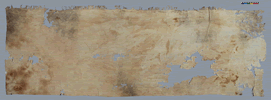 |
 |
 |
Items of ancient Egyptian dress
Click on the words for a link to the comments on each item below
the table
Click on the pictures for a larger image
Tarkhan complete sheet First Dynasty (about 3000 BC) UC 28670
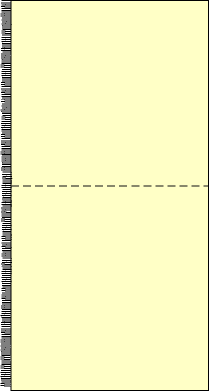 |
This 'rectangle' (Egyptian ifd, often translated as 'sheet') represents the basic item of Egyptian dress. This very early example, measuring c.283 x 105 cm and of good quality, no doubt would have belonged to a wealthy person. Before being put on it would have been folded end-to-end, creating a central transverse fold. If, rather than being used as a simple cloak, it was worn by a man in the manner of a kilt, it may also have been folded side-to-side, making a longitudinal fold. Worn thus it would have been tied on itself at the waist, with the fringed edge uppermost; the central transverse fold was at the front, reaching from the front of the waist down to the right shin. A belt or sash may have been worn over. An even longer version, up to 20 m, and attested by surviving examples dating from the late Old Kingdom through to the early 18th Dynasty, must have been folded into additional layers before draping. By the 18th Dynasty, tied versions of this garment are shown being worn by women, but arranged so as to cover the upper arms and breasts as well as the lower torso and legs. The ifd survived into the Ptolemaic and Roman periods - it was known in Greek as 'othonion' and the later woman's method of draping is represented in good detail on Roman-period Isis statues. |
Deshasheh dresses Fifth Dynasty (about 2400 BC) UC 31182 and 31183
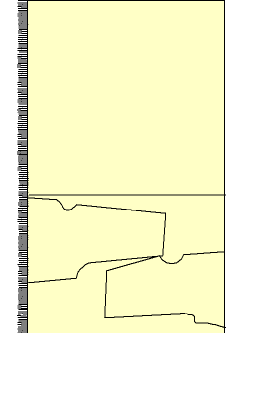 |
The two dresses from Deshasheh illustrate the sleeved version of the woman's long narrow dress that was worn throughout the early dynasties, Old Kingdom and Middle Kingdom. The version more commonly shown in art (early New Kingdom example) has one or two broad straps rather than sleeves as such. The cutting diagram shows how such dresses were made from a rectangular ifd, the fringe of the ifd reappearing down one side of the dress and along one side of the V-shaped neck opening. Click on the image below, showing one of the two dresses, for a larger picture. |
Tarkhan dress First Dynasty or Old Kingdom (about 3000-2300 BC) UC 28614Ai
 |
Many of the extant early dresses are pleated and the little dress from Tarkhan, tomb 2050, made in the same way as those from Deshasheh, retains pleating in the upper area. |
Tarkhan headband First Dynasty (about 3000 BC) UC 16355
 |
Among the mass of fragmentary clothing recovered by Flinders Petrie at Tarkhan, headbands identify themselves by their small proportions and often very fine quality. This example is not especially finely woven but is decorated with carnelian beads; it can be compared to the headband with a pattern of red flowers worn by the Princess Nefert from Meydum in the Cairo Museum. It is made from a narrow width of cloth, c.17 cm wide, gathered in at the ends by sewing. The beading suggests that is was folded on itself once more than shown here, that is giving a width of c.4 cm. |
Gurob sleeves New Kingdom (about 1400 BC) UC 8980A and B
 |
The pair of sleeves from Gurob, solidly woven and neatly sewn, retain the remains of a seam at the wider end. This shows that they were once attached to tunic. |
The 'bag tunic'
A wide rectangular tunic, mss, translated by the modern term 'bag tunic', began to be used in Egypt in the New Kingdom. It was worn by both men and women in addition to the ifd 'rectangle'. The great majority of surviving bag tunics are sleeveless, but plain sleeved examples were found in the tomb of the architect Kha while elaborately decorated examples in the tomb of Tutankhamun (both late 18th Dynasty).
Tarkhan bag tunic Third Intermediate Period (about 800 BC) UC 28616Bviii
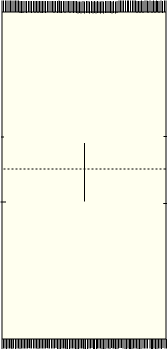 |
Extant New Kingdom bag tunics normally have a 'keyhole' shaped neck opening (a cut circle with a slit below). The very ragged bag tunic from Tarkhan, dating to the Third Intermediate Period, shows a later style of neck, a long vertical slit. The hem fringes front and back are also a later feature. This garment, very worn and extensively darned, illustrates well the typical condition of clothing found in 1st millennium burials (such semi-complete items were used for the lowest level of mummy wrapping). |
The diagram of the Tarkhan bag tunic illustrates how the bag tunic grew out of the older ifd 'rectangle': the central transverse fold of the rectangle became the tunic's shoulders, a neck hole being created through this; below the arms, the woven selvedges were seamed together.
Deshasheh kilt (Third Intermediate Period, about 800 BC?) UC 31173
Unprovenanced folded textile late Third Intermediate Period (about 670 BC) UC 55013
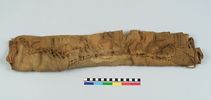 |
A narrower folded textile measuring c. 155 x 73 cm may be a man's sash. The long inscription, parallel to the fringe, is poorly preserved but parallels indicate a date in the 670s or 660s BC. |
This folded textile is a reminder that all these linen garments were stored folded up in chests. After laundering and before being put away they were folded several times down their length, as here. Wider items were additionally folded in the opposite direction. Any garment, when newly put on, would have exhibited the lines of these storage folds. Unlike pleating, however, storage folds were seldom represented in contemporary art
Copyright © 2003 University College London. All rights reserved.